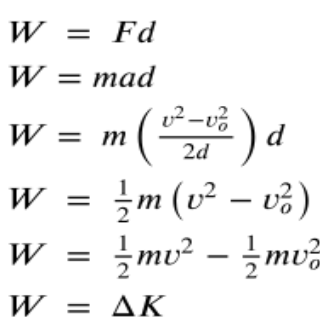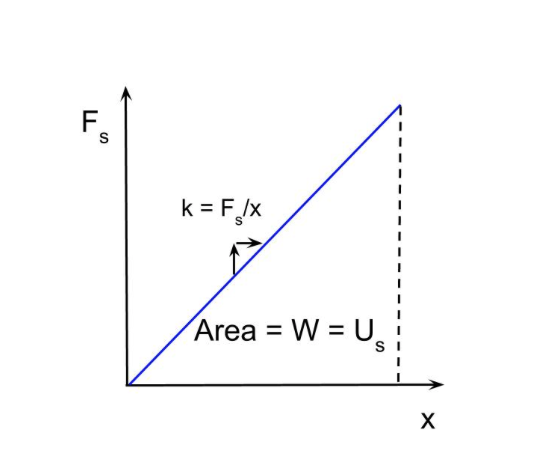Daniella Garcia-Loos
Peter Apps
Daniella Garcia-Loos
Peter Apps
AP Physics 1 🎡
257 resourcesSee Units
Changes in Kinetic Energy
A force exerted on an object can change the kinetic energy of the object.
Here are some key points about changes in kinetic energy:
- Kinetic energy is the energy of motion. It is the energy possessed by an object due to its motion or movement.
- Kinetic energy is proportional to the mass of the object and the square of its velocity. This relationship can be expressed using the formula: Kinetic energy = (1/2) * mass * velocity^2
- Changes in kinetic energy occur when an object speeds up, slows down, or changes direction.
- An increase in kinetic energy means that the object has gained energy, while a decrease in kinetic energy means that the object has lost energy.
- Changes in kinetic energy can be caused by external forces acting on the object, such as friction, gravity, or a collision.
- The change in kinetic energy of an object can be calculated using the formula: Change in kinetic energy = final kinetic energy - initial kinetic energy
Changes in Total Energy
Interactions with other objects or systems can change the total energy of a system.
Forces Can Change Kinetic Energy
The change in the kinetic energy of an object depends on the force exerted on the object and on the displacement of the object during the interval that the force is exerted.
Work and Mechanical Energy
Mechanical energy (the sum of kinetic and potential energy) is transferred into or out of a system when an external force is exerted on a system such that a component of the forces is parallel to its displacement. The process through which the energy is transferred is called work.
Kinetic Energy
Kinetic Energy (K) is energy an object has due to its motion. It can be calculated using the equation:

Where m is the mass of the object and v is the velocity. Notice that since the velocity term is squared, the kinetic energy of an object must always be positive. When work is done on an object to increase its speed, that work increases the object’s kinetic energy. To see how, let’s do a simple derivation.

We’re going to assume an object of mass m is being pushed by a net force (F) over some displacement (d). Using Newton’s 2nd Law and some kinematics:

we can substitute values in for the net force and acceleration.
Gravitational Potential Energy
Instead of increasing the velocity of the object, we might imagine work being done to change the position of the object. If the force is directed upwards, the object might gain height relative to the Earth (or some other reference point). In this case, the work being done is defined as changing the gravitational potential energy (Ug) of the object.

The equation above is the one most often used to calculate potential energy while the object is on or near the Earth. In fact, in order to have gravitational potential energy relative to the Earth, the Earth must be part of the system chosen.
However, it’s also possible to describe gravitational potential energy relative to non-Earth objects (or relative to Earth for a satellite or another planet). In this case, we define 0 potential energy to be a point that is an infinite distance away from the Earth. Therefore the closer to the Earth (or other planet) we get the more negative the potential energy becomes.

Elastic Potential Energy
A third type of energy that can be changed as a result of work is elastic potential energy. This is energy that is stored in a spring, rubber band, or other stretchable material. (For AP 1, this material is ideal, and obeys Hooke’s Law). Elastic Potential Energy for an ideal spring is described
by the equation:

Where k is the spring constant, and x is the displacement of the spring from its equilibrium position. The derivation of this equation is similar to the gravitational potential energy derivation, except the force is caused by Hooke’s Law and is dependent on x.
You may remember using a plot of Fs vs x to determine the spring constant for a spring. We can use the same plot to derive the energy stored in the spring too! Remember that Work is the area under the curve.


Image courtesy of Khan Academy.
Thermal Energy
This is a catch-all for any energy that isn’t potential or kinetic. We can talk about thermal energy as energy lost in the form of heat or sound. This is typically due to friction being present, but could also be due to heat from a collision. In AP 1, we don’t have a formal equation to define this, but AP 2 will go into more detail defining this.
Here are some key things to remember about different types of energy:
- Kinetic energy is the energy of motion. It is the energy possessed by an object due to its motion or movement.
- Potential energy is the energy of position or configuration. It is the energy stored in an object due to its position or arrangement in a system.
- Thermal energy is the energy of heat. It is the energy associated with the movement and interactions of the particles in a substance.
- Mechanical energy is the energy of a system that is associated with the motion and position of its parts. It is the sum of the kinetic and potential energies of the system.
- Electrical energy is the energy associated with the movement of electric charges. It is the energy used to power electrical devices and systems.
- Magnetic energy is the energy associated with the movement and interactions of magnetic fields. It is the energy used to power magnetic devices and systems.
- Gravitational energy is the energy associated with the gravitational force. It is the energy stored in an object due to its position in a gravitational field.
🎥Watch: AP Physics 1 - Unit 4 Streams
Browse Study Guides By Unit
👟Unit 1 – Kinematics
🌀Unit 2 – Dynamics
🚀Unit 3 – Circular Motion & Gravitation
⚡️Unit 4 – Energy
⛳️Unit 5 – Momentum
🎸Unit 6 – Simple Harmonic Motion
🎡Unit 7 – Torque & Rotational Motion
💡Unit 8 – Electric Charges & Electric Force
🔋Unit 9 – DC Circuits
🔊Unit 10 – Mechanical Waves & Sound
📚Study Tools
🧐Exam Skills

© 2024 Fiveable Inc. All rights reserved.